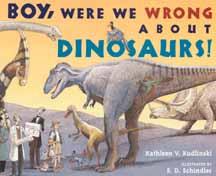Full Text Reviews: Bulletin for the Center... - 01/01/2006 What can be more delightful to a kid than to find that the grownups got it wrong? Here Kudlinski reviews a number of widely accepted “facts” about dinosaurs that later researchers have recanted with an embarrassed “Oops.” An excavated spike that was thought to adorn Iguanadon’s nose turns out to have belonged on its hand; legs that were supposed to have jutted out from the sides of lizardlike bodies are now believed to be positioned “straight under them, like a horse’s.” Then there were the early accusations of child—or egg—neglect leveled at errant dino parents; footprints now show dino tots being carefully protected within a herd, and hatchlings seem to have been cared for in their nests in ways lizards never enjoyed. Were they all massive animals? “Some grew no bigger than pigeons.” Gray skin? No, probably camouflaged. Smooth skin? No, possibly feathers. Schindler’s line-and-watercolor pictures, with their persnickety detailing and densely hatched texturing, are both convincing in their reconstructions of dinosaur appearance and humorous in their take on readjusted thinking (an Iguanadon skeleton accepts his correctly placed talon with a grateful “Ahh! Much better!”). Just before the closing source lists and timeline, Kudlinski aims the gentle barb, “There are still dinosaur books in libraries and bookstores that show the old ways of thinking.” Time to weed the fossils out of the 567.9s? - Copyright 2006 The Board of Trustees of the University of Illinois. School Library Journal - 12/01/2005 Gr 2-4-Kudlinski presents a number of early dino theories-a spike on the nose of the Iguanodon, drawings that depicted dinosaurs dragging their tails in the mud and running on spraddled, lizardlike legs-and shows, in her simple text, how further discoveries disproved these, and other, assumptions. She includes data on present-day concerns with such topics as scales and feathers, coloration, and infant care. She discusses the demise of the dinosaurs, the probable evolution of birds, and the fact that some books still on library shelves and even for sale in bookstores may be promulgating old, disproved theories. One small carp: lizards do not just "lay their eggs on the ground, then leave." They tend to dig holes or provide other shelter for their eggs first, and then, yes, they leave. Graced with colorful, realistic illustrations that reflect the text, this book is simple, attractive, and informative, and a take-off point for a discussion on the scientific method.-Patricia Manning, formerly at Eastchester Public Library, NY Copyright 2005 Reed Business Information. - Copyright 2005 Publishers Weekly, Library Journal and/or School Library Journal used with permission. Booklist - 12/01/2005 *Starred Review* What could be more heartening to children than the unabashed admission that grown-ups make mistakes? Science has had its share of theories once accepted as fact but later superseded, and the mystery of dinosaur fossils seems to have brought out the imaginative side of scientists. Beginning with the ancient Chinese, who decided that dinosaur fossils came from dragons that still lived, the story fast-forwards to nineteenth-century scientists, who guessed that Iguanodon's sharp, conical bone was a spike on its head, rather than a spur on its hand. One mistaken idea after another is examined and illustrated with an ink drawing juxtaposed against a single-color background. Further information comes to light, and the information is corrected on a page showing a dinosaur drawing tinted with full-color washes. Intelligently designed and imaginatively conceived, the artwork makes the text more understandable and the whole book more beautiful. It also reflects the outlook of the text, portraying the scientists of each generation as earnest, sometimes puzzled searchers who did the best they could with the evidence available. The ending returns to the Chinese beliefs, stating that if birds are the descendants of dinosaurs, then they still live. Best of all, the closing paragraph acknowledges that the search is not over yet: the children fascinated by this book may one day find new answers to old questions about the dinosaurs. - Copyright 2005 Booklist. Loading...
|



